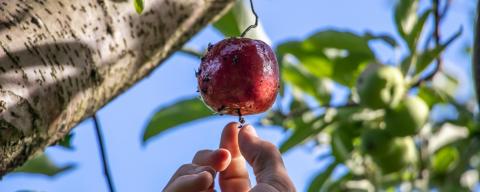Bitter rot is a fungal disease that primarily causes fruit rot of apples and pears. Bitter rot is caused by several species in the genus Colletotrichum including those in the C. gleosporioides and C. acutatum species complexes. In the Northeast, C. fioriniae of the C. acutatum species complex is the species most associated with bitter rot1. This disease thrives in warm, humid conditions and can lead to significant fruit losses if left unmanaged.
These pathogens are also responsible for causing anthracnose disease on peach, anthracnose fruit rot on blueberry and strawberry, and ripe rot on grape.
Description
The symptoms of bitter rot predominately appear on the fruit in July through post-harvest. Lesions on the fruit start off as small, circular, sunken spots. The spots can expand rapidly under warm, humid conditions. As lesion enlarge, they darken and may develop concentric rings. The center of the lesion can develop pink or orange spore masses. A distinctive diagnostic feature is the V-shaped, brown, watery lesion that extends toward the core when the fruit is cut open.
The fruit will eventually shrivel, mummify, and fall to the ground or remain hanging from the tree throughout the duration of the winter.
Leaf lesions and cankers are uncommon in New Hampshire.
Disease Cycle
The fungi overwinter in mummified fruits, dead wood, and other plant debris within the orchard. It has also been found to overwinter in buds. During spring and summer, especially under warm (80-90°F) and humid (80-100% relative humidity) conditions, spores are produced and dispersed by rain, wind, insects, and birds. Fruits are susceptible to infection from petal fall through harvest. The fungus is hemibiotrophic, meaning that the initial infection can have a latent or quiescent phase where the fungus is dormant in the apple. Maturity of fruit and temperature are the main factors that determine when the quiescent period ends and disease symptoms manifest, typically in mid to late summer.
As soon as infected fruit produce spores, these can cause new infections. Shoots killed by fire blight can be colonized by bitter rot fungi in the same year, adding to the inoculum source.
Research suggests that the fungus can also overwinter in many wild hosts including broad-leaf weeds and trees in the surrounding woods2.
Management
Cultural Practices:
- Prune trees to remove and destroy dead or diseased wood, including shoots infected with fire blight. This reduces the sources of inoculum.
- Eliminate mummified fruits from trees and the orchard floor to decrease overwintering sites for the fungi. Research has suggested that at least getting the mummified fruit off the tree and onto the ground can greatly decrease inoculum the next season3.
- Maintain tree vigor through proper fertilization, watering, and pruning to minimize stress, which can predispose trees to infection.
- Do not use susceptible cultivars. While no apple or pear variety is entirely immune to bitter rot, some are more susceptible (Fuji, Golden Delicious, and Empire). Additionally, bitter rot is more common on light or bicolored fruit (Empire, Honeycrisp, McIntosh, Sunrise, Paulared, and Jonagold).
Chemical Control
- Apply fungicides during the growing season, starting at fruit set. If there is a history of disease in the orchard, and thus an inoculum source, and prolonged warm, wet weather is predicted, a fungicide should be applied. For the most current fungicide recommendations, commercial growers are referred to the New England Tree Fruit Management Guide.
Table 1. Summary of key information on Bitter Rot
Summary Table |
|
|
Causal Agent |
Fungus |
|
Major Disease Symptoms |
Lesions on fruit that are sunken spots that may develop target-like concentric rings |
|
First Noticeable Symptoms |
On the fruit |
|
Plant Parts Infected |
Fruit |
|
Cultural Control |
Maintain healthy trees and remove any mummified fruits in the trees at the end of the season. |
|
Spray Program |
Protective sprays (with curative sprays when necessary) |
|
Number of Application per Season |
Varies |
References:
1 Martin, P. L., Krawczyk, T., Khodadadi, F., Aćimović, S. G., & Peter, K. A. (2021). Bitter Rot of Apple in the Mid-Atlantic United States: Causal Species and Evaluation of the Impacts of Regional Weather Patterns and Cultivar Susceptibility. Phytopathology, 111(6), 966–981. https://doi.org/10.1094/PHYTO-09-20-0432-R
2 Martin, P. L., & Peter, K. A. (2021). Quantification of Colletotrichum fioriniae in Orchards and Deciduous Forests Indicates It Is Primarily a Leaf Endophyte. Phytopathology, 111(2), 333–344. https://doi.org/10.1094/PHYTO-05-20-0157-R
3 Martin, P. L., King, W. L., Bell, T. H., & Peter, K. A. (2022). The Decay and Fungal Succession of Apples with Bitter Rot Across a Vegetation Diversity Gradient. Phytobiomes Journal, 6(1), 26–34. https://doi.org/10.1094/PBIOMES-06-21-0039-R
Extension Services & Tools That Help NH Farmers Grow
Receive Pest Text Alerts - Text UNHIPM to (866) 645-7010



